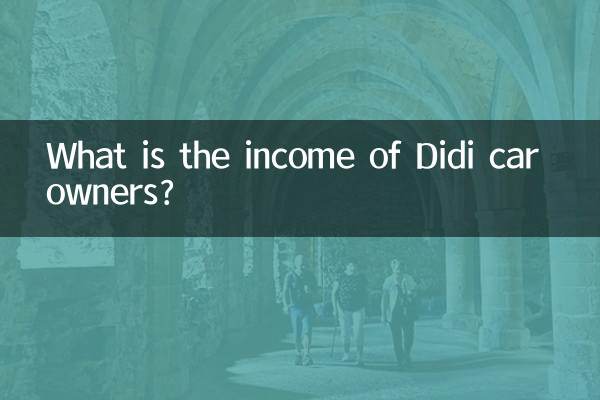What is the income of Didi car owners? Hot topics and data analysis on the entire network in the past 10 days
In recent years, the online ride-hailing industry has become one of the important options for flexible employment. As Didi is a leading domestic platform, the income of car owners has always been a hot topic of social concern. This article combines hot discussions and data from the entire Internet in the past 10 days to analyze the true income level of Didi car owners from the perspectives of income composition, regional differences, cost expenditures, etc.
1. Analysis of income composition of Didi car owners

The income of Didi car owners mainly consists of order flow, platform rewards and subsidies, but costs such as platform commissions, gas/electricity fees, vehicle wear and tear need to be deducted. The following is the typical income structure reported by recent car owners:
| project | Proportion/amount (daily average) | Remark |
|---|---|---|
| Order flow | 300-600 yuan | It is higher in first-tier cities and lower in third- and fourth-tier cities. |
| Platform commission (20%-30%) | 60-180 yuan | Floating according to car model and order type |
| Gas/electricity bill | 80-150 yuan | Fuel vehicles cost more |
| net income | 150-350 yuan | Actual amount received |
2. Significant differences in regional income
According to feedback from car owners and platform data, there is a large income gap in different cities, which is mainly affected by order density and freight standards:
| city level | Average daily net income (full-time) | Average monthly income (calculated based on 26 days) |
|---|---|---|
| First-tier cities (Beijing, Shanghai) | 250-400 yuan | 6500-10000 yuan |
| Second-tier cities (Chengdu, Hangzhou) | 200-300 yuan | 5200-7800 yuan |
| Third and fourth tier cities | 150-250 yuan | 3900-6500 yuan |
3. Key factors affecting income
1.Departure time: Most car owners said that they need to work an average of 10-12 hours a day to achieve a higher income level. 2.Order type: The commission for express trains is lower, but the unit price is also low; the commissions for premium and private trains are higher, but the income is more stable. 3.cost control: Due to low energy consumption costs, the net income of electric vehicle owners is generally 15%-20% higher than that of fuel vehicles. 4.Policies and subsidies: Some cities launch order rebates during holidays or events, which can increase revenue in the short term.
4. Real feedback from car owners: What you earn is hard-earned money
Recent hot discussions on social platforms show that most car owners believe that Didi’s income is “freer than part-time work, but it requires more physical effort.” A Beijing car owner shared: "I run 14 hours a day and earn 12,000 yuan a month, but after deducting car loans and insurance, I only have about 7,000 yuan left." In addition, changes in platform rules (such as adjustments to commission ratios) will also directly affect income.
5. Summary
Taken together, the income of Didi car owners is affected by multiple factors. Full-time monthly income is generally between 5,000-10,000 yuan, but they need to bear high-intensity work and vehicle costs. For drivers who plan to join, it is recommended to make a careful evaluation based on local market conditions and their own costs (such as whether to rent a car). The online ride-hailing industry is shifting from the "high subsidy era" to "refined operations", and the income structure may be further adjusted in the future.

check the details

check the details